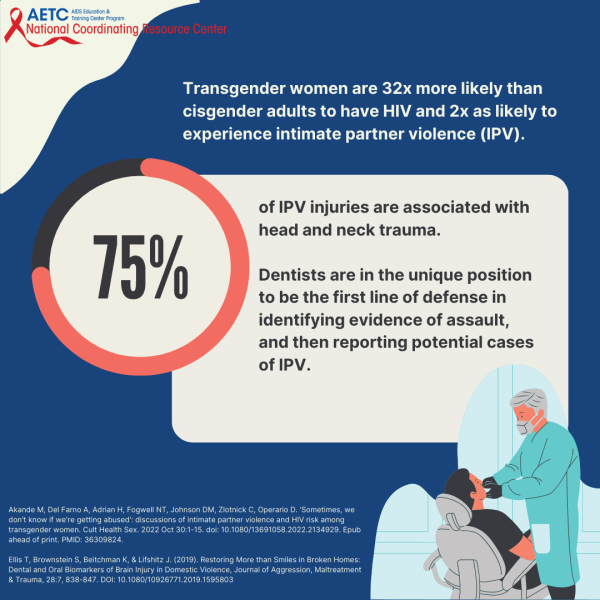Resources for HRSA HAB Performance Measures
The HIV/AIDS Bureau (HAB) of HRSA has developed a series of clinical performance indicators for Ryan White HIV/AIDS Program-funded clinics as part of...
The HIV/AIDS Bureau (HAB) of HRSA has developed a series of clinical performance indicators for Ryan White HIV/AIDS Program-funded clinics as part of...
This guide is designed to assist health professionals in evaluating medical and dental considerations for treating people with HIV in the era of ART...
This is the third version of Oral health affects your whole body. It’s an important part of your HIV care patient brochure. First published nearly 20...
This presentation is designed for oral health providers. It covers the following:
The slide set is for self-directed learning and downloadable for training purposes. The content addresses the following objectives:
1. Review the categ...
This updated dental brochure provides guidance for oral health providers caring for people with HIV during the COVID-19 pandemic. It provides an overv...
To address the importance of oral health and reduce oral health disparities for people with HIV, HRSA HAB identified challenges, best practices, and s...
The course explains the links between oral health and COVID-19, addresses patient and staff concerns about COVID-19 safety measures, reviews COVID-19...
Training slides highlight the importance of overall oral health and provide information on how to assist patients in recognizing their oral health nee...
Training slides provide tips for helping patients prepare for their dental visits and addressing fear in dental patients.
NEAETC recently published a new resource page, Oral Health and HIV, as part of its Online HIV Resource Library.
The Oral Health and HIV resource page p...
The Southeast AETC recognizes that HIV care is complex and challenging. Oral health providers, primary care providers, and other health professionals...
Learning objectives:

This infographic highlights the importance of a trauma-informed approach to dental care for people with HIV and offers recommendations for integrating...
This self-paced asynchronous course covers tobacco use in people with HIV, the pillars of tobacco treatment, strategies for harm reduction, and more...
The purpose of this resource is to increase clinician awareness of the increased prevalence of specific illnesses and mortalities among people with HI...
Weekly newsletter about NEAETC’s upcoming educational programming and resources...
Training slides review the following:
This webinar describes the relationship between aging and oral health and its pertinence to the health of people with HIV.
(Recorded 2/12/24)
Sexually transmitted infections (STIs) often manifest orally, and with proper screening and diagnosis, these infections...
(Recorded 3/20/24)
This webinar provides a basic overview of HIV as a chronic medical condition, describes prevention and post-exposure rec...
The delivery of oral healthcare brings a certain level of risk to the dental healthcare worker, part of which can be linked to a blood exposure. The b...
People with HIV experience a high incidence of common oral health problems (e.g., dental decay/cavities, gingivitis) as well as other oral health prob...
Upon watching this video viewers will :
The U.S. Department of Health and Human Services currently recommends that every person with HIV begin antiretroviral therapy (ART) as soon as possible after diagnosis. Increased availability of testing and treatment along with the above guidelines have reduced the number of new HIV infections by 18...
It is estimated that 1.1 million people in the United States are infected with HIV. Of those, 1 in 7 do not know they are infected.[1] The number of new HIV diagnoses fell 19% from 2005 to 2014.[1] Because HIV testing rates have remained stable or increased in recent years, this decrease in diagnose...
The question I most commonly get asked by oral health providers is...
Do I pre-medicate patients based on a high viral load and low CD4 count?
There is no supporting data to support the need for routine antibiotic coverage pre or post dental treatment based on the CD4 or viral load. Antibiotic use in...
A recent study that was conducted among 1200 HIV patient of whom 600 each belonged to with ART and without ART and the occurrence of oral candidiasis and oral hairy leukoplakia. This study shows that oral candidiasis and leukoplakia was less among patients on ART as well as a decrease in the number...
I often get this question from non-dental personnel including case managers, physician assistants, nurses, and nurse practitioners. The following is a short list of questions you can ask patients to guide dental referrals for emergency care:
HPV oral and oropharyngeal cancers are more difficult to detect than tobacco-related cancers because the symptoms are not always obvious to an individual, and health professionals may lack the education and background to diagnose HPV-related lesions. Although there are many adjunctive oral cancer sc...
Antiretroviral therapy (ART) has been very successful at preserving immune function and controlling opportunistic infections among individuals infected with HIV. Oral mucosal diseases associated with advanced immunosuppression, including candidiasis and hairy leukoplakia, are significantly less comm...
The emergence of chronic disease complications in controlled HIV disease has changed the landscape of HIV clinical care. HIV infection confers an increased cardiovascular disease risk which is thought to be due to a complex interplay of mechanistic factors. While traditional cardiovascular risk fact...
As the global battle to understand and eliminate the coronavirus continues, a new study published in the Journal of Dental Research demonstrates that testing of oropharyngeal secretions (OS) may reduce the number of false-negative results from nasal swab testing of patients who have seemingly recove...